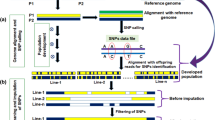Abstract
Precise molecular characterisation of genetic modifications integrated into the genomes of genetically modified organisms (GMOs) and of their flanking genomic regions forms a key component for the development of event-specific detection methods. In the EU, this information is of particular importance for risk management in cases where genetic modifications of unauthorised GM food, feed or seeds are detected. PCR-based chromosome walking approaches are commonly used for DNA sequence determination of the genetic modifications and of the flanking genomic regions in yet undescribed GM plants. If the plant contains complex and re-arranged modifications, sequencing and molecular characterisation are often difficult and laborious. Next-generation sequencing (NGS) of DNA is a powerful alternative tool to rapidly generate primary sequence data on the genome of so far uncharacterised sample material if pure GMO material is available. Recently, robust NGS platforms and affordable sequencing services are accessible for food and feed control laboratories. We here present a NGS-based study for whole-genome sequencing of the GM rice event LLRice62 as a proof-of-principle experiment to develop bioinformatics easy-to-use data analysis tools for rapid molecular characterisation. A total of 171,657,155 read mate pairs of approximately 75 bp each were obtained. Sequence reads belonging to the genetic modifications and their flanking genomic regions in LLRice62 were identified by bioinformatic comparison to the corresponding Oryza sativa ssp. japonica reference genome sequence using the Illumina InDel caller software and subsequent iterative mapping of retrieved NGS reads. An entire genetic modification of 1,493 bp in the genome of the LLRice62 sample material was determined and correctly mapped on chromosome 6. The determined nucleotide sequence coincides to the genetic modification described by the developer of this rice event. This study demonstrates for the first time the applicability of NGS for molecular characterisation of uncharacterised GMOs.




Similar content being viewed by others
References
Arai-Kichise Y, Shiwa Y, Nagasaki H et al (2011) Plant Cell Physiol 52:274–282
Babekova R, Funk T, Pecoraro S, Engel KH, Busch U (2009) Eur Food Res Technol 228:707–716
Bonfini L, van den Bulcke MH, Mazzara M, Ben E, Patak A (2012) J AOAC International 95:1713–1719
Cao J, Schneeberger K, Ossowski S (2011) Nat Genet 43(10):956–963
EFSA (2007) The EFSA Journal 588, 1–25, http://www.efsa.europa.eu/de/efsajournal/pub/588.htm. Accessed 22 July 2013
Feltus A, Wan J, Schulze SR, Estill JC, Jiang N, Paterson AH (2004) Genome Res 14:1812–1819
Franck G, Guille M, Jonard G, Richards K, Hirth L (1980) Cell 21:285–294
Gürtler P, Meissner E, Busch U (2011) Abschlußbericht zum Projekt Nachweis von nicht zugelassenen gentechnisch veränderten Organismen (GVO): Weltweite Ermittlung, Importanalyse und Entwicklung von Nachweis-Methoden; LGL Oberschleißheim
Hajdukiewicz P, Svab Z, Maliga P (1994) Plant Mol Biol 25:989–994
IRGSP (International Rice Genome Sequencing Project) (2005), Nature 436:793–800
Kovalic D, Garnaat C, Guo L (2012) The Plant Genome 5(3):149–163
Li H, Durbin R (2009) Bioinformatics 25:1754–1760
Li H, Handsaker B, Wysoker A et al (2009) Bioinformatics 25:2078–2079
Milcamps A, Rabe S, Cade R, De Framond AJ, Henriksson P, Kramer V, Lisboa D, Pastor-Benito S, Willits MG, Lawrence D, van den Eede G (2009) J Agric Food Chem 57(8):3156–3163
Miller JR, Koren S, Sutton G (2010) Genomics 95(6):315–327
Monsanto Company (2000) Updated molecular characterization and safety assessment of Roundup Ready soybean event 40-3-2, http://cera-gmc.org/docs/decdocs/gts40-3-2-update.pdf. Accessed 22 July 2013
Pietrzak M, Shillito RD, Hohn T, Potrykus I (1986) Nucleic Acid Res 14(14):5857–5868
Pop M (2009) Brief Bioinform 10(4):354–366
Rice P, Longden I, Bleasby A (2000) Trends Genet 16(6):276–277
Schweizer HP (1993) Gene 134:89–91
Spalinskas R, van den Bulcke M, van den Eede G, Milcamps A (2013) Food Anal Methods 6:705–713
The International Brachypodium Initiative (2010) Nature 463:763–768
Waiblinger H, Grohmann L, Mankertz J, Engelbert D, Pietsch K (2010) Anal Bioanal Chem 396:2065–2072
Wang C, Jiang L, Rao J, Liu Y, Yang L, Zhang D, Agric J (2010) Food Chem 58:11543–11547
Yanisch-Perron C, Vieira J, Messing J (1985) Gene 33:103–119
Zhang Z, Schwartz S, Wagner L, Miller W (2000) J Comput Biol 7(1–2):203–214
Conflict of Interest
Daniela Wahler has no conflict of interest. Leif Schauser has no conflict of interest. Joachim Bendiek has no conflict of interest. Lutz Grohmann has no conflict of interest. This article does not contain any studies with human or animals subjects.
Author information
Authors and Affiliations
Corresponding author
Rights and permissions
About this article
Cite this article
Wahler, D., Schauser, L., Bendiek, J. et al. Next-Generation Sequencing as a Tool for Detailed Molecular Characterisation of Genomic Insertions and Flanking Regions in Genetically Modified Plants: a Pilot Study Using a Rice Event Unauthorised in the EU. Food Anal. Methods 6, 1718–1727 (2013). https://doi.org/10.1007/s12161-013-9673-x
Received:
Accepted:
Published:
Issue Date:
DOI: https://doi.org/10.1007/s12161-013-9673-x




